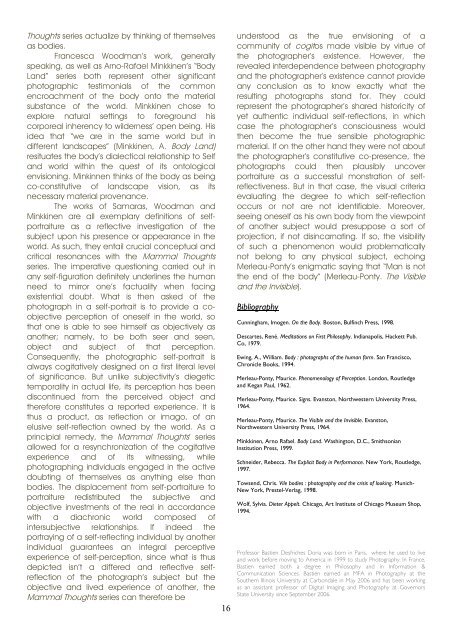Meet Animal Meat - Antennae The Journal of Nature in Visual Culture
Meet Animal Meat - Antennae The Journal of Nature in Visual Culture
Meet Animal Meat - Antennae The Journal of Nature in Visual Culture
Create successful ePaper yourself
Turn your PDF publications into a flip-book with our unique Google optimized e-Paper software.
Thoughts series actualize by th<strong>in</strong>k<strong>in</strong>g <strong>of</strong> themselves<br />
as bodies.<br />
Francesca Woodman’s work, generally<br />
speak<strong>in</strong>g, as well as Arno-Rafael M<strong>in</strong>kk<strong>in</strong>en’s “Body<br />
Land” series both represent other significant<br />
photographic testimonials <strong>of</strong> the common<br />
encroachment <strong>of</strong> the body onto the material<br />
substance <strong>of</strong> the world. M<strong>in</strong>kk<strong>in</strong>en chose to<br />
explore natural sett<strong>in</strong>gs to foreground his<br />
corporeal <strong>in</strong>herency to wilderness’ open be<strong>in</strong>g. His<br />
idea that “we are <strong>in</strong> the same world but <strong>in</strong><br />
different landscapes” (M<strong>in</strong>kk<strong>in</strong>en, A. Body Land)<br />
resituates the body’s dialectical relationship to Self<br />
and world with<strong>in</strong> the quest <strong>of</strong> its ontological<br />
envision<strong>in</strong>g. M<strong>in</strong>k<strong>in</strong>nen th<strong>in</strong>ks <strong>of</strong> the body as be<strong>in</strong>g<br />
co-constitutive <strong>of</strong> landscape vision, as its<br />
necessary material provenance.<br />
<strong>The</strong> works <strong>of</strong> Samaras, Woodman and<br />
M<strong>in</strong>kk<strong>in</strong>en are all exemplary def<strong>in</strong>itions <strong>of</strong> selfportraiture<br />
as a reflective <strong>in</strong>vestigation <strong>of</strong> the<br />
subject upon his presence or appearance <strong>in</strong> the<br />
world. As such, they entail crucial conceptual and<br />
critical resonances with the Mammal Thoughts<br />
series. <strong>The</strong> imperative question<strong>in</strong>g carried out <strong>in</strong><br />
any self-figuration def<strong>in</strong>itely underl<strong>in</strong>es the human<br />
need to mirror one’s factuality when fac<strong>in</strong>g<br />
existential doubt. What is then asked <strong>of</strong> the<br />
photograph <strong>in</strong> a self-portrait is to provide a coobjective<br />
perception <strong>of</strong> oneself <strong>in</strong> the world, so<br />
that one is able to see himself as objectively as<br />
another; namely, to be both seer and seen,<br />
object and subject <strong>of</strong> that perception.<br />
Consequently, the photographic self-portrait is<br />
always cogitatively designed on a first literal level<br />
<strong>of</strong> significance. But unlike subjectivity’s diegetic<br />
temporality <strong>in</strong> actual life, its perception has been<br />
discont<strong>in</strong>ued from the perceived object and<br />
therefore constitutes a reported experience. It is<br />
thus a product, as reflection or imago, <strong>of</strong> an<br />
elusive self-reflection owned by the world. As a<br />
pr<strong>in</strong>cipial remedy, the Mammal Thoughts’ series<br />
allowed for a resynchronization <strong>of</strong> the cogitative<br />
experience and <strong>of</strong> its witness<strong>in</strong>g, while<br />
photograph<strong>in</strong>g <strong>in</strong>dividuals engaged <strong>in</strong> the active<br />
doubt<strong>in</strong>g <strong>of</strong> themselves as anyth<strong>in</strong>g else than<br />
bodies. <strong>The</strong> displacement from self-portraiture to<br />
portraiture redistributed the subjective and<br />
objective <strong>in</strong>vestments <strong>of</strong> the real <strong>in</strong> accordance<br />
with a diachronic world composed <strong>of</strong><br />
<strong>in</strong>tersubjective relationships. If <strong>in</strong>deed the<br />
portray<strong>in</strong>g <strong>of</strong> a self-reflect<strong>in</strong>g <strong>in</strong>dividual by another<br />
<strong>in</strong>dividual guarantees an <strong>in</strong>tegral perceptive<br />
experience <strong>of</strong> self-perception, s<strong>in</strong>ce what is thus<br />
depicted isn’t a differed and reflective selfreflection<br />
<strong>of</strong> the photograph’s subject but the<br />
objective and lived experience <strong>of</strong> another, the<br />
Mammal Thoughts series can therefore be<br />
16<br />
understood as the true envision<strong>in</strong>g <strong>of</strong> a<br />
community <strong>of</strong> cogitos made visible by virtue <strong>of</strong><br />
the photographer’s existence. However, the<br />
revealed <strong>in</strong>terdependence between photography<br />
and the photographer’s existence cannot provide<br />
any conclusion as to know exactly what the<br />
result<strong>in</strong>g photographs stand for. <strong>The</strong>y could<br />
represent the photographer’s shared historicity <strong>of</strong><br />
yet authentic <strong>in</strong>dividual self-reflections, <strong>in</strong> which<br />
case the photographer’s consciousness would<br />
then become the true sensible photographic<br />
material. If on the other hand they were not about<br />
the photographer’s constitutive co-presence, the<br />
photographs could then plausibly uncover<br />
portraiture as a successful monstration <strong>of</strong> selfreflectiveness.<br />
But <strong>in</strong> that case, the visual criteria<br />
evaluat<strong>in</strong>g the degree to which self-reflection<br />
occurs or not are not identifiable. Moreover,<br />
see<strong>in</strong>g oneself as his own body from the viewpo<strong>in</strong>t<br />
<strong>of</strong> another subject would presuppose a sort <strong>of</strong><br />
projection, if not dis<strong>in</strong>carnat<strong>in</strong>g. If so, the visibility<br />
<strong>of</strong> such a phenomenon would problematically<br />
not belong to any physical subject, echo<strong>in</strong>g<br />
Merleau-Ponty’s enigmatic say<strong>in</strong>g that “Man is not<br />
the end <strong>of</strong> the body” (Merleau-Ponty. <strong>The</strong> Visible<br />
and the Invisible).<br />
Bibliography<br />
Cunn<strong>in</strong>gham, Imogen. On the Body. Boston, Bulf<strong>in</strong>ch Press, 1998.<br />
Descartes, René. Meditations on First Philosophy. Indianapolis, Hackett Pub.<br />
Co, 1979.<br />
Ew<strong>in</strong>g, A., William. Body : photographs <strong>of</strong> the human form. San Francisco,<br />
Chronicle Books, 1994.<br />
Merleau-Ponty, Maurice. Phenomenology <strong>of</strong> Perception. London, Routledge<br />
and Kegan Paul, 1962.<br />
Merleau-Ponty, Maurice. Signs. Evanston, Northwestern University Press,<br />
1964.<br />
Merleau-Ponty, Maurice. <strong>The</strong> Visible and the Invisible. Evanston,<br />
Northwestern University Press, 1964.<br />
M<strong>in</strong>kk<strong>in</strong>en, Arno Rafael. Body Land. Wash<strong>in</strong>gton, D.C., Smithsonian<br />
Institution Press, 1999.<br />
Schneider, Rebecca. <strong>The</strong> Explicit Body <strong>in</strong> Performance. New York, Routledge,<br />
1997.<br />
Towsend, Chris. Vile bodies : photography and the crisis <strong>of</strong> look<strong>in</strong>g. Munich-<br />
New York, Prestel-Verlag, 1998.<br />
Wolf, Sylvia. Dieter Appelt. Chicago, Art Institute <strong>of</strong> Chicago Museum Shop,<br />
1994.<br />
Pr<strong>of</strong>essor Bastien Desfriches Doria was born <strong>in</strong> Paris, where he used to live<br />
and work before mov<strong>in</strong>g to America <strong>in</strong> 1999 to study Photography. In France,<br />
Bastien earned both a degree <strong>in</strong> Philosophy and <strong>in</strong> Information &<br />
Communication Sciences. Bastien earned an MFA <strong>in</strong> Photography at the<br />
Southern Ill<strong>in</strong>ois University at Carbondale <strong>in</strong> May 2006 and has been work<strong>in</strong>g<br />
as an assistant pr<strong>of</strong>essor <strong>of</strong> Digital Imag<strong>in</strong>g and Photography at Governors<br />
State University s<strong>in</strong>ce September 2006.












